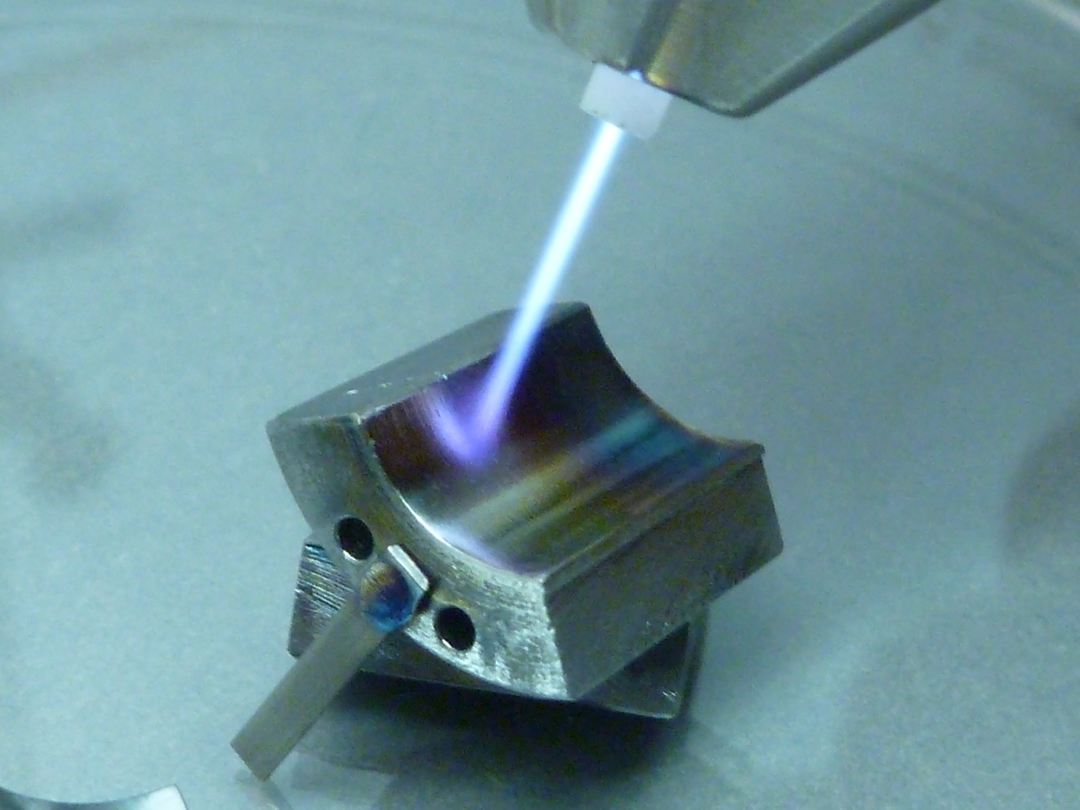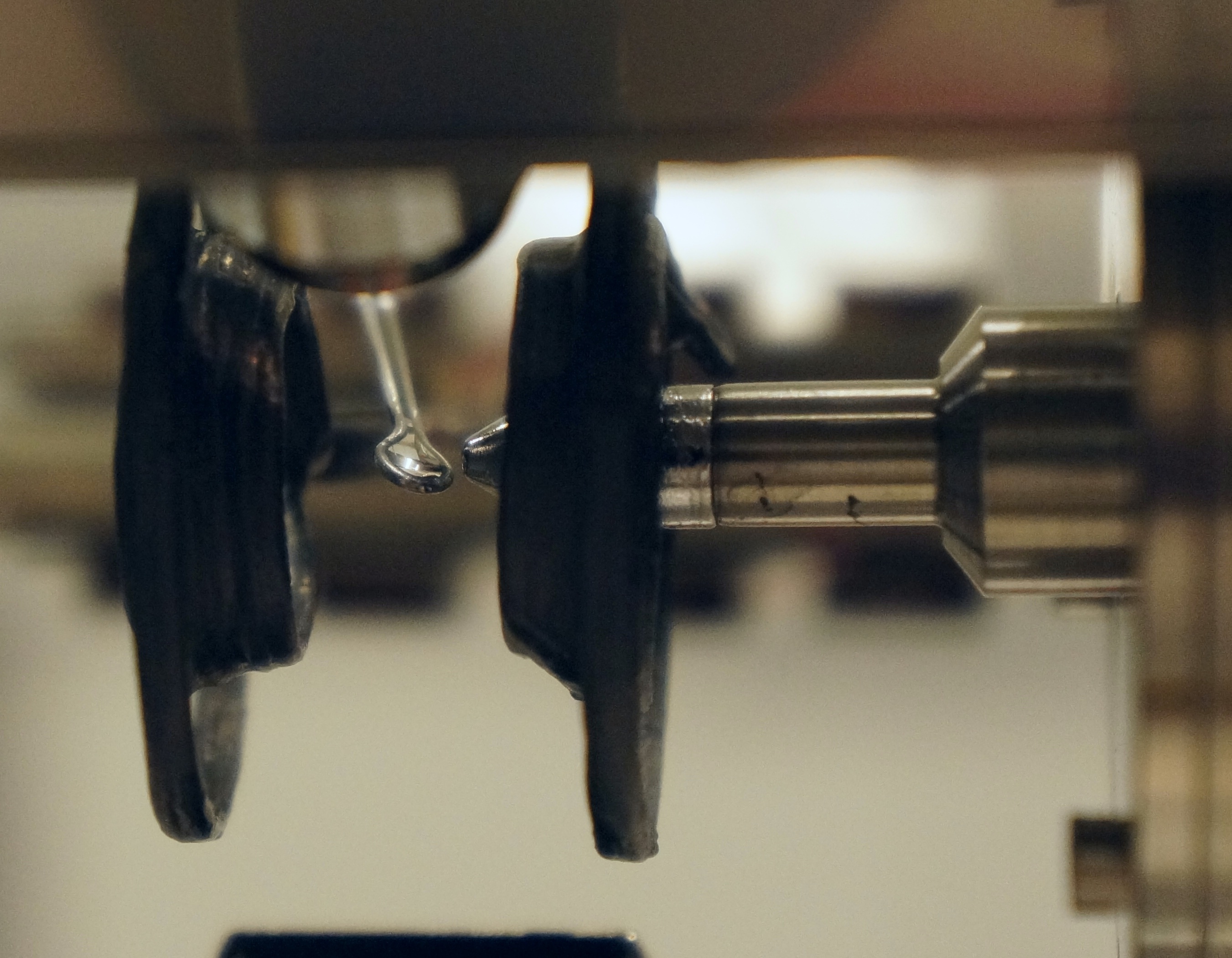Michael Allan Physics and Chemistry with Free Electrons
Filament
Replacing burn-out filaments has always been one of the more delicate tasks. Sometimes they were not as nicely centered as on this picture — but it did not hurt, there were deflectors short distance along the beam which could bent the beam back to the desired path.
Plasma pen
Periodic cleaning of the machine was a very time-consuming, delicate and risky task. Once I listened to a talk on atmospheric pressure plasmas, in particular on the plasma pen and decided to try.
The result was initially promissing — the pen cleaned the discolored lens surface within perhaps 1-3 minutes to become perfectly shiny.
Then came the disappointment - after a lenghty assembly we found that the instrument did not work well at all. I can only speculate that the plasma pen coated the Molybdenum with a thin layer of oxide, perfectly transparent to make it appear perfectly clean, but insulating, leading to surface charging...
Plasma pen
The cleaning method which brought the best resolution and beam current was electropolishing. Not very pleasant, though, the solution was a mixture of concentrated phosphoric and sulfuric acids. Shiny surface results only when the current density exceeds about 1 A/cm2, meaning hot wires, sparks,... Also, the molybdenum dissolves quite quickly. Note the strange shape of the cathode — it has a "spike" — the spike goes into the lens cylinder during the polishing (without touching it). This makes the current density high on the inner surface of the lens cylinder — because that's where the lens must be clean. The outer surface does not matter.
BE EXTREMELY CAUTIOUS IF YOU DO THIS!! PROTECT YOUR EYES AND HANDS! DON'T SPILL THE ACID OVER YOUR KNEES! WORK IN A HOOD. PUT EVERYTHING INTO A BIG TRAY SO THAT THE ACID DOES NOT SPILL IN CASE THAT THE GRASSWARE BREAKS OR SLIPS OUT OF YOUR HAND.
Rainbow
The photo shows the (rectangular!) pupil aperture of the "gun lens", after perhaps a month or two of nearly uninterrupted operation.
The electron beam does some chemistry with the sample molecules adsorbed on the molybdenum surface, possibly turning them into radicals which subsequently polymerize and form a thin transparent layer.
The layer becomes thicker towards the center of the beam, leading to repetitive interference patterns. The layer is thus about 3 wavelenghts of green light thick!
Wien filter
Light and heavy particles — electrons and anions — follow the same trajectories in purely electrostatic systems and one thus does know — do I see scattered electrons or anions from Dissociative Electron attachment?
The work-around is a small Wien filter in the last lens before the channeltron.
The deflection by the Wien filter is along the slit — not perpendicularly, as one may expect. This reduces the mass resolution — and it already happened that I was told "Mike you made a mistake". But no, it is intentional. The "sweet" direction of bending, that by the hemispherical analysers, is perpendicular to the slit, as it should be, giving nice energy resolution. And having Wien filter and hemispheres deflecting in the same direction is bad - there would be "intertalk", small magnetic deflection would appear as a small energy shift - I certainly did not want that. They must be perpendicular!
Beam profile
I always wished to see what the profile of the electron beam is, but there is no easy way to see it. Any kind of device measuring it will also strongly perturb the beam — there is no way. But then this trace appeared. The beam is weak, but after perhaps a month of operation it causes enough coloration to see it. It is like a photograph with one month exposition time.
It appears as a line because of the energy-dispersion by the hemispheres.
Ionic liquid
A droplet of an ionic liquid is held on a small Molybdenum wire loop in the collision region. Gas inlet is on the right, the electron beam comes from the top. The black objects left and right are the solenoids of the Magnetic Angle Changer. The droplet can be pulled out while in vacuum to permit tuning of the spectrometer using helium sample.
February 2020 (MA)

